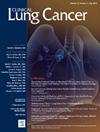First-Line Pembrolizumab Efficacy in Octogenarians With NSCLCs Expressing ≥ 50% PD-L1 (ESCKEYP GFPC 05-2018)
IF 3.3
3区 医学
Q2 ONCOLOGY
引用次数: 0
Abstract
Background
Pembrolizumab alone is a first-line therapeutic option for patients with metastatic non-small cell lung cancer (NSCLC) with ≥ 50% PD-L1 expression, but few data are available for elderly patients, specifically octogenarians.
Methods
This retrospective, multicenter study included all consecutive patients with metastatic NSCLC PD-L1 ≥ 50% treated with first-line pembrolizumab monotherapy between May 2017 and November 2019. Information was collected from medical files with local evaluation of therapeutic response and progression-free survival (PFS).
Results
Among the 844 patients included, 73 (8.4%) were ≥ 80 (median: 82) years old, 74% men, 23.3% with ECOG-PS ≥ 2, 26% had ≥ 5% weight loss, PD-L1 50%-75%/≥ 75%: 45.2%/46.6%, respectively, with significantly more nonsmokers and (17.4% vs. 5.6%, P = .0002) and fewer adenocarcinomas (57.5% vs. 70.8%, P = .0217) than those < 80 years. After median follow-up of 45.7 (95% CI: 43.0-49.1) months, respective median overall survival (OS) for octogenarians versus younger patients lasted 12.0 (95% CI: 7.7-16.2) versus 23.9 (95% CI: 19.5-27.4) months (P = .0002), and median PFS for 5.0 (95% CI: 2.8-9.2) versus 8.3 (95% CI: 7.2-9.8) months (P = .039). Their respective objective response rates did not differ significantly: 42% (95% CI: 24-60) vs. 49% (95% CI: 43-54).
Conclusions
Based on the results of this large multicenter population, first-line pembrolizumab efficacy against NSCLCs expressing ≥ 50% PD-L1 in octogenarians seems inferior to that obtained in younger patients. The higher percentage of nonsmokers and fewer adenocarcinomas could partially explain that finding.
一线派姆单抗在PD-L1表达≥50%的80岁非小细胞肺癌患者中的疗效(ESCKEYP GFPC 05-2018)。
背景:单独使用派姆单抗是PD-L1表达≥50%的转移性非小细胞肺癌(NSCLC)患者的一线治疗选择,但很少有数据可用于老年患者,特别是80多岁的患者。方法:这项回顾性多中心研究纳入了2017年5月至2019年11月期间接受一线派姆单抗单药治疗的所有连续转移性非小细胞肺癌PD-L1≥50%患者。从医疗档案中收集有关治疗反应和无进展生存期(PFS)的当地评估信息。结果:在纳入的844例患者中,73例(8.4%)≥80岁(中位:82),男性占74%,ECOG-PS≥2的占23.3%,体重减轻≥5%的占26%,PD-L1 50%-75%/≥75%:45.2%/46.6%,与< 80岁的患者相比,非吸烟者明显增多(17.4% vs. 5.6%, P = 0.0002),腺癌较少(57.5% vs. 70.8%, P = 0.0217)。中位随访45.7个月(95% CI: 43.0-49.1)后,80岁老人和年轻患者的中位总生存期(OS)分别为12.0 (95% CI: 7.7-16.2)和23.9 (95% CI: 19.5-27.4)个月(P = 0.0002),中位PFS为5.0 (95% CI: 2.8-9.2)和8.3 (95% CI: 7.2-9.8)个月(P = 0.039)。他们各自的客观反应率没有显著差异:42% (95% CI: 24-60)对49% (95% CI: 43-54)。结论:基于这一大型多中心人群的结果,派姆单抗对80多岁患者中PD-L1表达≥50%的非小细胞肺癌的一线疗效似乎不如在年轻患者中获得的疗效。较高的非吸烟者比例和较少的腺癌可以部分解释这一发现。
本文章由计算机程序翻译,如有差异,请以英文原文为准。
求助全文
约1分钟内获得全文
求助全文
来源期刊

Clinical lung cancer
医学-肿瘤学
CiteScore
7.00
自引率
2.80%
发文量
159
审稿时长
24 days
期刊介绍:
Clinical Lung Cancer is a peer-reviewed bimonthly journal that publishes original articles describing various aspects of clinical and translational research of lung cancer. Clinical Lung Cancer is devoted to articles on detection, diagnosis, prevention, and treatment of lung cancer. The main emphasis is on recent scientific developments in all areas related to lung cancer. Specific areas of interest include clinical research and mechanistic approaches; drug sensitivity and resistance; gene and antisense therapy; pathology, markers, and prognostic indicators; chemoprevention strategies; multimodality therapy; and integration of various approaches.
 求助内容:
求助内容: 应助结果提醒方式:
应助结果提醒方式:


